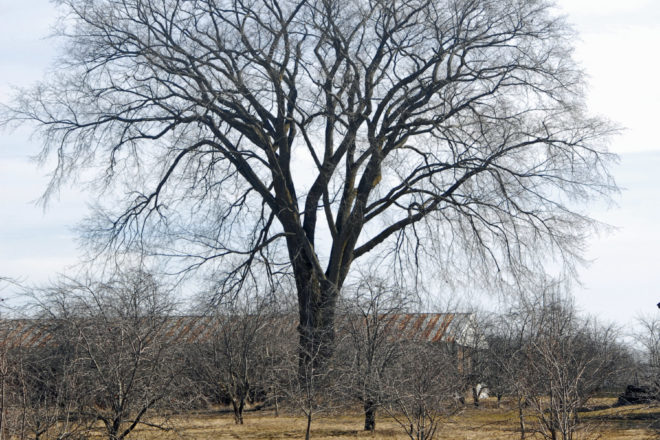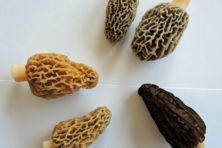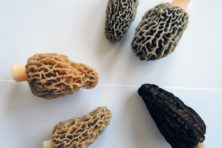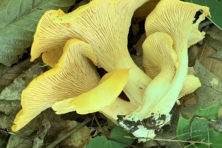Trees and Mushrooms: How Are They Connected
- Share
- Tweet
- Pin
- Share

It was in the autumn of 1993 when my late husband, Roy, and I set out on a four-week driving trip to see the mountains and giant trees of the Pacific Northwest. We had both taught classes at The Clearing Folk School in Ellison Bay and were eager to see some of the places that John Muir had written about.
We traveled through southern Minnesota and walked trails at Pipestone National Monument, where tributes were made to the Native people who used that material for their peace pipes. The next day included a scenic drive through South Dakota’s Badlands National Park, and then on to see Devil’s Tower in northeastern Wyoming.
Seeing these places was on Roy’s “bucket list.” The Bighorn Mountains of Wyoming were spectacular, with lenticular clouds hovering over them. Mule deer and pronghorns were active along some of the back-country roads as we headed to Montana.
Another focus of our journey was to go along parts of the Lewis and Clark Highway. Friends had told us about Lolo Pass, which took us to the border with Idaho in the Bitterroot Range of the Rockies. I took lots of notes while Roy did most of the driving, and I remember seeing – just after going over the pass – a road sign that said, “Winding Road Next 77 Miles.”
One of our main destinations was the Olympic Peninsula to see the environment near the Pacific Ocean. We hiked in the Hoh Rain Forest and marveled at the size of Douglas firs and the lush vegetation in Olympic National Park.
A disturbing site was areas of clear-cut timber. Whole hillsides were bare of any vegetation. A narrow line of conifers was left along the road, perhaps to hide the destruction beyond, but it was sad to see this.
I just finished reading a fabulous book, Finding the Mother Tree, by Suzanne Simard. She grew up in the wilds of British Columbia and was working on her research while we were on this trip.
Many years of rugged fieldwork taught Simard that old-growth trees are so important for the life of all the other trees in a forest, and clearing everything was the worst land management. She was rebuked many times but kept on working to study how best to grow trees.
And here’s where mushrooms come in. Wild mushrooms grow from mycelium – a vast, intertwining network of fibers in the soil that helps trees – and certain mushroom species are often associated with particular kinds of trees. This vital web is made up of various types of mycelia called mycorrhizal fungi.
Many tree roots are linked by ectomycorrhiza – a network that surrounds tree roots and fans out to connect the roots with other trees. Another type, endomycorrhiza, not only covers tree roots, but actually penetrates them. This helps to conduct minerals and water to the tree, and the trees, in return, transfer carbon and other nutrients to the mycelium to help it grow and continue to benefit nearby trees.
Another type of mycorrhizal network is called arbuscular. It is found with cedar trees and penetrates the cells of other vascular plants as well. Studies done in British Columbia showed that even wildflowers and grasses are connected to mycelial threads in the soil.
During the early years of our marriage, Roy and I would ride our bikes north and west of Baileys Harbor. I remember seeing an unusual tree that Roy called a wolf pine hidden in a wooded area. The tree had a very thick trunk, with heavy branches throughout. He felt that loggers had left it because of all the thick, low branches. Now I think of it as a “mother tree.”
Studies have shown that big, older trees in high, dry elevations actually transfer their moisture to nearby younger trees during the night through the vast mycorrhizal network: hundreds of species of mycorrhizal fungi that help many plants to connect, communicate and benefit each other.
One study that Simard carried out during her early years showed that birch trees left in a plantation help the firs that are seeded in. Many test plots were made to see how this was happening.
These researchers also found that trees that were planted after removing all of the other vegetation were more susceptible to drought and insect infestation. The mountain pine beetle, for example, caused a blue-stain fungus infection that cut off the flow of water in the xylem of the tree. Conversely, planting trees in places where other tree species and soil mycelium remained intact helped the new seedlings to ward off insect attacks.
We are learning that all life on Earth is connected, and what we do to injure parts can affect many other parts. Hopefully, understanding this will help all of us in the future.




